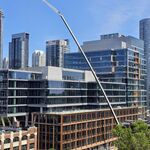evandyk
Senior Member
Especially when 2 of the 4 lanes were parking for 22 hours of the day.
The trouble is that we are driving development onto all the potential car priority roads. So Toronto's plan is to have zero car priority roads (leaving aside highways), or to force tens of thousands of people to live in condos on busy car priority roads. It's kind of insane, to my mind.Toronto doesn't have a good solution due to the nature of our road system. We need some streets to allow for fast movement around the city and others should allow for fast bike travel across the city. Due to where our bike lanes are setup, we should have some of the other streets like Dundas West optimized for car travel. One weekend, I was driving on Queen street, all the parking was removed and most importantly, the TPA was driving along the parked lanes removing all the cars. That should be how it is for every rush hours (and always in certain spots like around Eaton Centre). I also think that Toronto got a bit ahead of itself putting bike lanes west of Jane on Bloor. The many condos will come with no car parking and tons of bike parking, but right now that's 7-10 years away.
Stuff like this is when the blue hair people protest ford in person, it’ll wave off opposition as “crazy people”is it derogatory to call someone a carbrain?
Minus the car travel lanes, there's no where for cars! Where will it end!Minus the dedicated curb cutouts which aren’t travel lanes there was no parking allowed on the new section
There's no good reason for them to stop anywhere. Mississauga is building an extensive cycling network of its own after all, even if it is mostly poorly designed.How far west should it go? I'm ok with sections that make sense (east of jane basically in my book)
4.4% as Northern Light mentioned. And that's only going to go up.That's only true if bikes end up making more than 2% of the traffic.
Travel habits are adjusting to the new cycling infrastructure, which is the subject of this entire thread. Travel times are certainly not way up in the bike lanes. Or the subway, which has far more capacity than anything on the surface. And car travel times being up is mostly limited to specific locations and likely temporary.Where are travel habits "adjusting" to? The subway is packed at peak times, the Gardiner capacity reduction has been in place for months but travel times are still way up.
Canadians love to use winter as an excuse for the status quo. But the reality is that when cycling infrastructure is separated from traffic and ploughed in the winter, people use it all year. Just like sidewalks.I'm curious why nobody ever mentions poor weather days or the winter months as if they don't exist. I'm very hopeful usage goes up but as someone who lives near this area, I don't really see things increasing much more
The trouble is that we are driving development onto all the potential car priority roads. So Toronto's plan is to have zero car priority roads (leaving aside highways), or to force tens of thousands of people to live in condos on busy car priority roads. It's kind of insane, to my mind.
I’m pointing out there was no illegal parking in this new stretch. I’ll do my recording next week and see what sort of volume we see.Minus the car travel lanes, there's no where for cars! Where will it end!
Winter is no longer an excuse for Toronto at least. We barely got snow this year (thank you climate change?). This has been my best winter by far for biking.There's no good reason for them to stop anywhere. Mississauga is building an extensive cycling network of its own after all, even if it is mostly poorly designed.
4.4% as Northern Light mentioned. And that's only going to go up.
Travel habits are adjusting to the new cycling infrastructure, which is the subject of this entire thread. Travel times are certainly not way up in the bike lanes. Or the subway, which has far more capacity than anything on the surface. And car travel times being up is mostly limited to specific locations and likely temporary.
Canadians love to use winter as an excuse for the status quo. But the reality is that when cycling infrastructure is separated from traffic and ploughed in the winter, people use it all year. Just like sidewalks.
Illegal parking is everywhere, abandon your car in a live traffic lane if you don't believe me.I’m pointing out there was no illegal parking in this new stretch.
Winter is no longer an excuse for Toronto at least. We barely got snow this year (thank you climate change?). This has been my best winter by far for biking.
People don't park illegal there as there is plenty of parking AND there isn't really anything to stop for, it's an issue further east but not this section.Illegal parking is everywhere, abandon your car in a live traffic lane if you don't believe me.
I worked at richmond near university, I'd have a good view of 2 cycle lanes. The usage wouldn't be zero but it would be a lot lower than the summer.Yeah our winters are so overblown. I average less than 5 days a year where I don't bike due to snow. We barely get any snow here. I think a lot of people who live to the away from the waterfront don't realize how little snow we actually get downtown. I miss more days due to rain than I do due to cold or snow.




